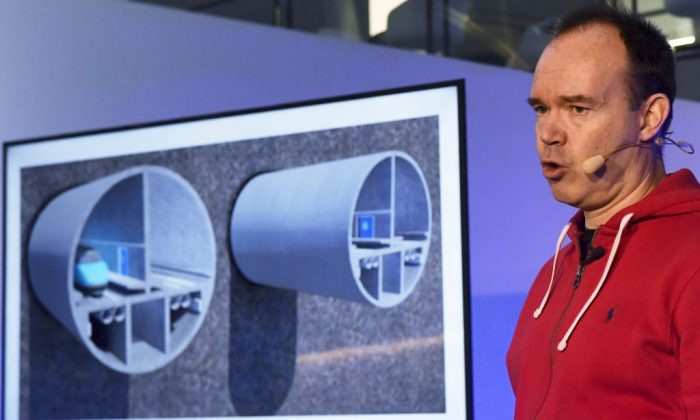
Peter Vesterbacka, co-founder of the Finest Bay Area Development, is seen during the press conference about the Helsinki-Tallinn tunnel in Helsinki, Dec. 3, 2018. (Vesa Moilanen/AFP/Getty Images)
Chinese Funding for Finland-Estonia Bridge Questioned by Locals
March 17, 2019
In Europe, Chinese funding for a proposed undersea rail tunnel linking Finland and Estonia is raising concerns in both nations.
The tunnel, which would span the Gulf of Finland and link the Finnish capital of Helsinki with the Estonian capital of Tallinn, has for years been a topic of discussion between the two countries. The rail would cut travel time between the two capitals to about 20 minutes from the current two-hour ferry ride.
There is frequent cross-border travel between the two countries. Tens of thousands of Estonians commute across the Gulf of Finland to work in the Helsinki area, while the Estonian capital is a popular tourist destination for Finns.
Currently, Finnish businessman Peter Vesterbacka and his company, FinEstBay Area Development, is heading the effort to build the tunnel, which is expected to cost between 15 billion to 20 billion euros ($17 billion to 23 billion). The company envisions that the tunnel, consisting of a rail for freight and another rail for passenger transport, be operational by the end of 2024.
In December last year, FinEstBay Area secured external funding of 100 million euros ($113 million) from Dubai-based construction company ARJ Holding, according to Reuters.
On March 8, FinEst Bay Area announced on its website that it had signed a memorandum of understanding (MoU) for 15 billion euros ($16.8 billion) in financing from Touchstone Capital Partners, a UK-based investment firm that specializes in doing business with China. As a result of the deal, Touchstone would become a minority shareholder in the project.
Kenny Song, Touchstone’s chairman and founder, described the tunnel as a “common focus between Estonia and Finland on Asia-Europe.”
According to Reuters, FineEstBay Area has yet to secure approval from the Finnish and Estonian governments, or the European Union.
More details about the Touchstone financing and the negotiations leading up to the signing of the MoU was published in a March 8 article by Finnish newspaper Helsingin Sanomat (HS).
According to HS, negotiations between FineEstBay Area and Touchstone began when Yan Jinxiu, deputy director of China’s Chinese Railway Academy, which is subordinate to the state-run company China Railway Group, visited the Finnish city of Vantaa to participate in a local tunnel seminar in September last year. Yan is also currently a member of the Academy’s Chinese Communist Party committee, according to the Academy’s website.
Concerns
Touchstone would finance the construction of the tunnel through its $100 billion One Belt One Road (OBOR) fund, according to HS.
According to the company’s website, it established the investment fund to help connect Chinese state-owned firms with international companies to jointly invest in OBOR projects—”with a particular focus on renewable energy, high-technology, infrastructure, real estate, and tourism industries.”
Touchstone is capitalizing on China’s OBOR initiative, which began in 2013 with the goal of building Beijing-centered land and maritime trade networks by financing infrastructure projects throughout Southeast Asia, Africa, Europe, and Latin America.
Touchstone boasts that it’s inked strategic agreements with many Chinese state-owned companies that can act as engineering and construction contractors to carry out OBOR projects. In terms of financing, the company points out that it has agreements with Chinese leading investors, such as trust, private, and government funds.
The company also claims to have access to capital from Chinese policy banks, such as China Development Bank, the Export-Import Bank of China, and Industrial and the Commercial Bank of China.

Touchstone’s intentions for investing in the tunnel have since been questioned by Jyrki Kallio, senior researcher at the Finnish Institute of International Affairs, according to his March 12 opinion article published in Finnish business newspaper Kauppalehti.

“From China’s perspective, the tunnel project would be understandable, if the tunnel had a connection to a harbor on the shore of the Arctic Ocean,” Kallio stated. But this tunnel project doesn’t seem to fit into Beijing’s agenda for OBOR, he added.
As part of OBOR, China has expressed interest in creating a new shipping route that goes through the Arctic, taking advantage of the melting Arctic ice sheet. The route, called the “Northern Sea Route” by Beijing, would save money and time compared to the traditional shipping routes through the Suez Canal.
Kallio warned that since “there are strategically important state-owned companies behind the financier, so this is mostly about China’s state-operated action.”
Uusi Suomi, a local Finnish daily newspaper, ran an editorial on March 9, called out Touchstone as a “Communist Chinese tool for implementing One Belt, One Road.” It also pointed out should the deal go through, China could end up taking control of the tunnel because it would be the creditor.

Urmas Paet, Estonia’s former foreign minister and currently a member of the European Parliament, also issued a warning in a statement to the Estonian News Agency, saying that “the risks connected to using money from Chinese state companies are too high,” according to New Europe, a weekly English-language newspaper based in Brussels. Paet urged the Estonian government to try to secure funding from the European Union instead.

No comments:
Post a Comment
Comments always welcome!